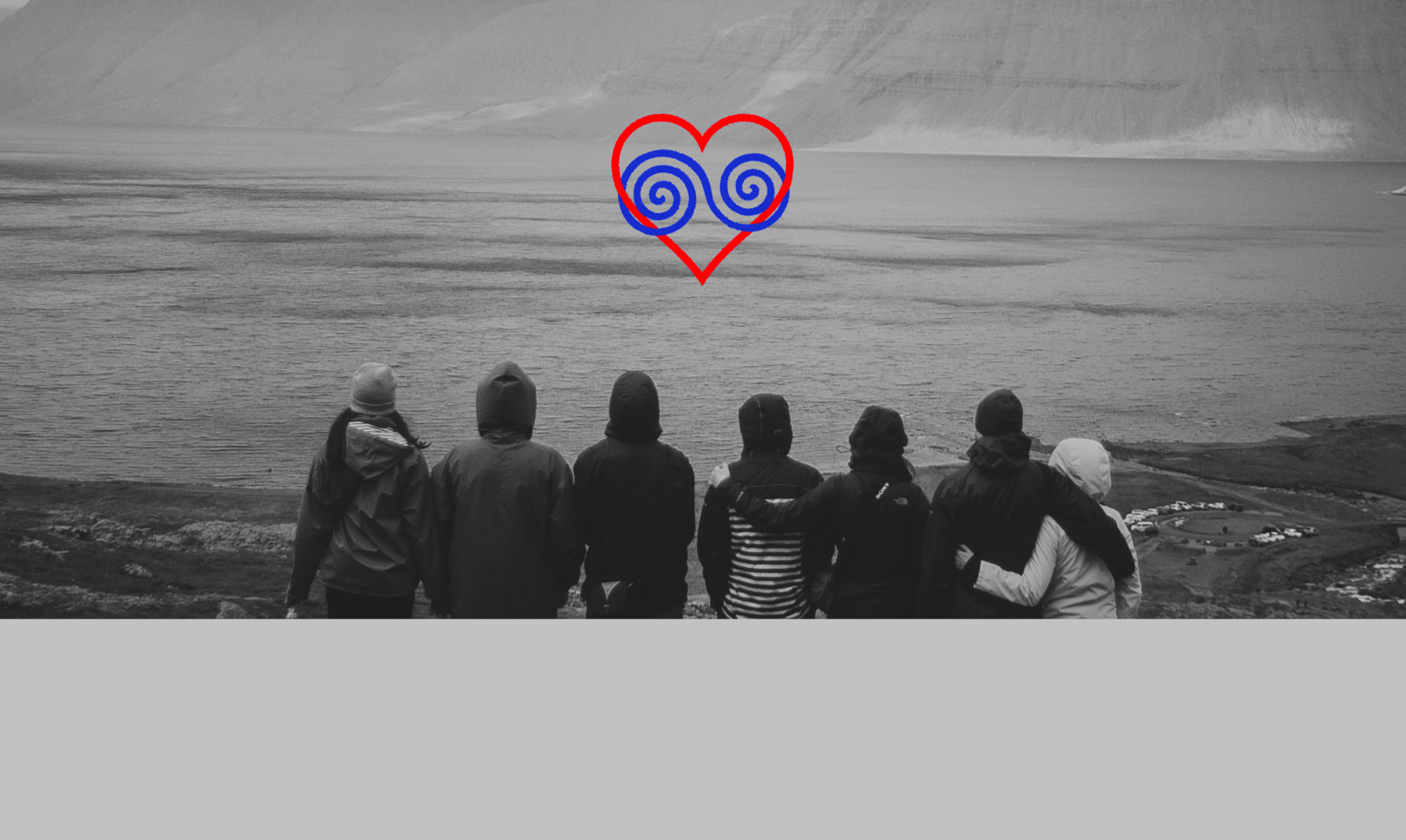Power Of Three ¹
While in the last three entries I have once again dealt with the philosophical and spiritual background of Oligoamory, this time I would like to concentrate a (little) bit more on its actual practice. Since I have been confronted in the past few weeks more often with the question “what” would characterise somebody as a “real Oligoamorist” – or “how” a relationship is distinguished as “oligoamorous” in a competent way, I have pondered which aspects should be considered from my point of view, whenever someone wants to get involved in an oligoamorous kind of relationship.
I have already addressed these aspects here on my bLog at various points – and I will refer to them accordingly; however, it was important to me to sketch a more specific three-step process, “how” the initial steps toward an oligoamorous multiple relationship on a personal level might look like.

Question 1: Why do I want to be part of an oligoamorous multiple relationship at all?
First and foremost – as I already counted “sincerity” and “honesty” in Entry 3 among the basic values of Oligoamory, it is imperative that we apply them to ourselves as consistently as to any potential partner(s). And it is not without reason that in Entry 46 I declare “self-knowledge” to be one of the most important ideals of this relationship philosophy. Moreover, it is almost an established fact that a strong focus of ours should always rest on a very important relationship: That one to ourselves.
Since the media and social networks are usually happy to promote at this point the advantages of the multifunctional fulfilment of needs by increasing the number of optional partners, it is again extremely important for me (since Entry 2) to emphasize that this kind of “resource exploitation” is never the intention of Oligoamory. Alas, many open relationship models and unfortunately also a lot of “multiple lovers” in Polyamory are rather short-sighted concerning this issue.
Becoming aware of one’s own needs, even that we have needs at all, how their “mixture” – or rather their level of “(ful)filment” – is currently composed in our life, is indeed a very essential part of thorough self-perception and self-knowledge. Unfortunately however many people then stop exactly at this point of their self-exploration journey with just this level of knowledge, thus elevating their identified need(s) to their top priority and thereby to the argumentative starting point of their aspiration for multiple relationships.
But if we visualize our happiness like a traditional, upright standing rain barrel, where the needs are – so to speak – the barrel staves (the planks that make up a barrel), then our well-being (which is the contents) in this happiness-barrel can only rise as high as the shortest stave allows. If, for example, our “staves” (= needs) such as safety, communication, creativity, efficacy, etc. are tall and strong, our happiness-barrel can still not hold more well-being than the only half-height stave “comfort” allows, if we have a deficit in exactly this need, just because this plank is shortened or reduced: Since exactly at this point, any “more” well-being that we would try to gather in our barrel will be drained precisely via this “shortened” need.
So if we have a need, which is “curtailed” in this sense, then we feel above all its “shortage” in a sense of neediness – since “only” this darned one stave would have to be mended or raised, so that we could experience “more” happiness and well-being (which the other staves would easily and surely provide!). If we would now give in to the above mentioned, medially praised, short-sighted need-management, we might now try to stuff a person into this “need-gap”, so that he*she*it both prevents a further outflow of our well-being at this point and also provides for an overall increase of our happiness-level…
Get it? Does it dawn on you why this can’t work – at least not as a basis for any relationship at eye level?
On the one hand, in this way we “use” a person like a requirement (and this is something people will notice sooner or later – and will react with resignation, flight or rebellion), on the other hand we try to solve our own problem with a completely useless manipulation: Another ordinary mortal-limited-fallible human being CAN never be able to fill this “gap” in ourselves. Even more: Due to his*her*its mortal-limited fallibility we will regularly a) experience disappointments with this person, if – in our view – it does not fulfil the function, which we have assigned, properly, and b) we have thereby also created a scapegoat to the outside world, to which we can constantly attribute guilt or blame, if the filling level in our own “happiness-barrel” decreases for any reason.
So when I speak of self-knowledge and consciousness-raising in regard to Oligoamory, I mean that we should become extremely honestly aware of our own internal weaknesses and strengths. For this is where the issues are to be found that are not immediately smoothed and levelled out in a multiple relationship, as with a soothing layer of warm chocolate, but rather exactly those that we will (have to) deal with and work through in the process with our potential loved ones, as they will usually come to light very quickly (and most likely with some intensity).
Question 2: Do I have enough space for another complete human being in my life?
Already from the section above a partial answer to this question automatically results. For if I cannot fragment or compartmentalize other people in order to employ them as “quickfix”, as patch or fill-in for one of my deficits – shabbily concealed under the polyamorous flag of “multiple love” – then to my understanding it is part of the content of the adjective “ethical” in “ethical multiple relationships” that I regard every “him”, “her” or “it” as a complete and legitimate person, and consequently grant him, her or it all the appreciation as personality and living being that I desire for myself as well. Precisely because of this unconditional “grant” I already ask in my Entry 30
- Whether there is room for a WHOLE (additional) person in my already rich life (I recall the Anaïs Nin quote from Entry 6, “that each new person represents a world in us, a world not born until they arrive, and it is only by this meeting that a new world is born”).
- Whether I’ve tidied up my “inner space” sincerely enough to let a (additional) person in – or if I only provide a tight spot in front of my best-decorated showcase.
- Whether I am currently a secure harbour where another person can be safe enough to get rid of their “everyday armour”.
- Whether I have enough inner certainty that I do not have to cling to myself, in the panic of losing myself – but have both an arm for me and an arm for somebody else to welcome him*her*it, to encourage him*her*it – and to endure him*her*it.
Without the factual capacity (in terms of rather down-to-earth resources, including time) and the courage to get involved with a “whole person”, we too will otherwise not be able to find peace in a multiple relationship (strictly speaking: in no relationship!), because – as I wrote in Entry 55 – “»getting acquainted with each other« means seeking answers to the questions »Who are you – Who am I?«”. Precisely for this purpose, however, all parties involved need a certain degree of certainty that the others in this process are about as serious as oneself concerning the intent of intimacy, familiarity and closeness in matters of integrity and commitment.
Someone, who is available in such a case e.g. only for a few hours at the weekend and otherwise manages his remaining everyday life like a small private kingdom, appears in this regard more or less as coherent as a counterpart, which during a conversation is fixed all the time to the display of a mobile phone…
In one of my comments on Entry 55 some time ago I quoted the therapist and author Mike Hellwig², who once said “that – in order to establish a sustainable relationship with one another beyond the usual society-conforming role clichés – partners are required who are aware that they may be compensating and who are willing to consciously open their wounds, to virtually seek them out and show them to one another.” In this respect, one might criticize that I might be putting too much emphasis on “shortcomings” or at least on “curative potential” in my version of Oligoamory. But that is not how I want to be understood: I choose mainly the “tough”, “hard” or supposedly “problematic” examples, because in my experience it is very easy to handle and enjoy almost every relationship in reasonably cheerful weather. This usually also requires little active personal determination. But whether we are in the process of building a mature relationship with eye level on all sides, will always only be proven in a storm, when not everything is running smoothly or things fit harmoniously together. And exactly for this purpose it is important that we have clarified for ourselves beforehand whether we are prepared – because it could become difficult, unpleasant, and unsexy – to allow another person to touch us “completely” in our very being with difficulties, with unpleasant sides and unsexyness. And if we are prepared to accept uncertainty within us that we cannot always know what this in turn will trigger in ourselves. Which is why I emphasized in Entry 55: It’s oligoamorous, if we really want that.
Question 3: What about my existing emotional contracts?
One of the most important entries on this bLog is Entry 9, in which I refer to our invisible and mostly implicit “emotional contracts”, which we establish in each of our close relationships. If you want to celebrate yourself now because – to your knowledge – you have not yet entered any relationship in this sense and consider yourself to be supposedly “contract-free”, I would like to say that almost all our closer relationships with living beings are subject to emotional contracts, be it relatives in need of care, parents or children – but, of course, also pets, volunteer work or even jobs.
In my opinion, “ethical multiple relationships” differ from “unethical multiple relationships” by our attitude towards the question of how we generally relate to commitment and self-obligation: Are we the “moral chameleon” that I have already mentioned in some of my entries, which changes depending on surroundings and circumstances – or are we striving to maintain our once declared attitude with integrity, even if this means that we might not be able to hide away for once, maybe even have to prove the ability to take some blows?
The latter would in any case be a good quality to own as a representative of a non-conformist way of living and loving, e.g. if one gets into inevitable contact with the “normal world”.
By their very nature, emotional contracts are great things: because by them we prove to be predictable relationship-shareholders who care for their stuff – and own their sh*. At the same time, they are incredibly dynamic; they actually call for a high and transparent level of communication with the other beings involved in the contract, because it is so important that all parties really understand the same thing by what has been agreed upon. At the same time, this creates a leeway which must therefore always be collectively readjusted and also leaves room for renegotiation and expansion.
But since, precisely for this reason, “emotional contracts” are not watertight written treaties that forever gather dust in some locked up safe, but, as I wrote in entry 9, “highly subjective, »felt« arrangements of giving and taking (or more gently: contributing and enjoying) in human relationships”, their true quality is revealed a little more in our attitude toward them than in their virtual content.
This means: A person of integrity in a relationship signals respect for the other participants in a relationship by speaking and acting in such a way that the other participants can recognize that the person speaking or acting is part of a committed, larger “we”.
What seems to sound so complicated here, I have explained in Entry 53 and simply called it “considering the others”. It is the opposite of egocentricity and mere self-interest – and if we succeed in reflecting this kind of appreciation to the people with whom we already have some kind of relationship, then the rest, as they say, are (negotiable) details. Multiple relationships deal with human beings on all levels – therefore it is of enormous importance to give this “human factor” top priority on all levels, be it towards ourselves, be it towards a person in whom for whatever reason our interest has flared up – and especially towards those persons with whom we are already in a (close) relationship.
The mindset towards our existing relationships (and thus our “existing contracts”) shows how our self-imposed integrity (= acting in constant compliance with the personal value system) is linked to our overall attitude of appreciation and predictability.
I write “overall attitude” because a careless or trifling approach towards established commitments in existing relationships speaks a clear language, not only – how we will most likely treat the next desired person in the same way – but also how we will probably address ourselves inside us as well: Someone, who (for whatever reasons) isn’t worth all this…
We therefore prove to be self-efficient and responsible when we start to integrate our desire for multiple relationships especially within our existing emotional contracts. Because at this point at the latest, we have dealt with resistances of the “human factor” on various levels – individual, in partnership and super-personal.
So, if a motto of soccer is “keep the box clean”, I would recommend, with regard to Oligoamory, to start with the care for these three boxes:
1) Reason for own desire
2) Space in your own life
3) Existing emotional contracts
I wish you the very best!
¹ I borrowed the title for this entry from the fantasy-author Diane Wynne Jones, who – by the way – established with this book 1976 an impressive example for integration and cooperation.
² Mike Hellwig, born in 1964, after studying the German language and literature, turned to psychology and developed the method of Radical Allowing as a therapist.
Thanks to jacqueline macou on Pixabay for the photo.


Hallo Oligotropos!
Danke für diesen durchdachten Artikel! Und die sehr schöne Parabel mit den Fassdauben. Ich finde es ungemein faszinierend, wie du und ich aus zwei völlig verschiedenen Blickwinkeln – und mit anderen Worten – zu ähnlichen Schlussfolgerungen gelangen. Gerade dein “Um-Zu” finde ich lustig – ich sage zu demselben “Sekundärmotivation”, und meine Lebensgefährtin nennt es “unverbundenes Um-Zu”. Du bist da auf einer ergiebigen Spur 😉
Lg sacriba
Das “Um-zu” ist ja nicht meine “Erfindung” ?. Ich kenne es u.a. aus ganz anderen Zusammenhängen, wie z.B. der freien Pferdearbeit nach Klaus Ferdinand Hempfling oder auch aus dem Kontext des feministischen Buddhismus, wie er etwa von Sylvia Wetzel vertreten wird.
Allen diesen Philosophien ist gemeinsam, daß dort überall die Betonung darauf liegt, eine Herangehensweise nicht als “Technik” oder “Methode” zur bloßen (egoistischen) Zielerreichung einzusetzen, sondern als ganzheitliche Lebensweise, die sich Zusammenhänge erschließt und durch die man, Schicht für Schicht, auch immer mehr von sich selbst freilegt.